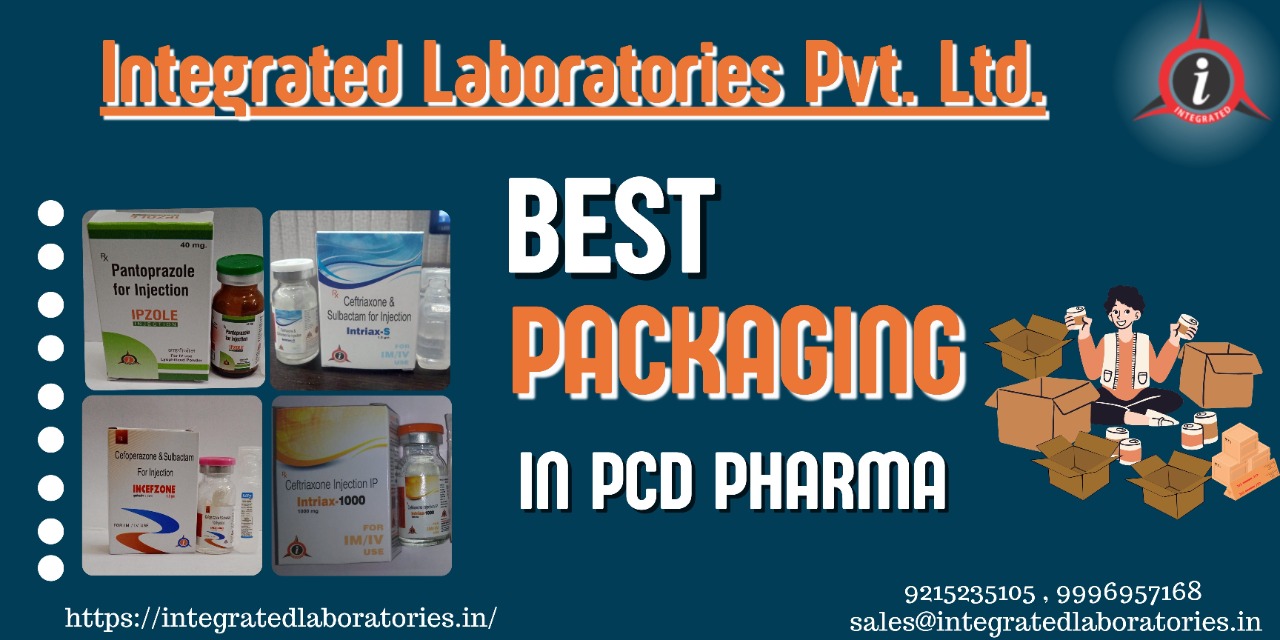Best Packing In PCD Pharma Company - Integrated Laboratories
Best Packing PCD Pharma Is a result of recent technological advancements among the top innovators in Integrated Laboratories Pvt. Ltd..
The assortment of various elements that surround a pharmaceutical product from the moment it is produced until it is used is known as pharmaceutical packaging materials. As a result, the word “Pharmaceutical Packaging” can be used to refer to the science, art, and technology of enclosing or protecting items for distribution, storage, sale, and consumption, including printed material used in a pharmaceutical product’s finishing. From the point of manufacturing until it is utilized or administered, it provides identity, presentation, protection, information, and convenience in an affordable way.
Depending on its purpose and the type of material used, pharmaceutical packaging can take a variety of forms. Finally, all packing materials must be examined by testing on chosen samples, sterilization, storage, and stability tests. The packaging of pharmaceutical medicines is crucial to maintaining their quality.
ROLE OF PHARMACEUTICAL PACKAGING
Lifesaving pharmaceuticals, surgical equipment, blood and blood products, nutraceuticals, powders, liquid and dosage forms, solid and semisolid dosage form, are all delivered in pharmaceutical packaging that fundamentally ensures containment, drug safety, identification, convenience of handling, and delivery
PHARMACEUTICAL PACKAGING
PRIMARY PACKAGING: This is the initial packaging envelope that comes into contact with the medication or equipment. Pharmaceuticals should be properly contained by the packaging, which should not interact with the medicine.
Examples of such packaging include blister packaging, strip packaging, alu-alu packaging, etc.
SECONDARY PACKAGING: This is a continuous covering or package for the grouping that contains pharmaceutical items, such as carton, boxes etc.
TERITARYPACKAGING: It is used for bulk handling and transportation of pharmaceuticals from one location to another, such as containers, barrels, etc.
FUNCTIONS OF PACKAGING
BARRIER PROTECTION: It is intended to protect the product from any external forces that might modify its qualities, such as moisture, light, oxygen, and temperature changes. Blister packaging can give this form of protection (Pharma-grade Barrier films and Eco-friendly Halogen- free films).
BIOLOGICAL PROTECTION:- It is intended to defend against biological pollutants.
PHYSICAL PROTECTION: It is intended to protect pharmaceutical dosage forms from physical damage.
INFORMATION COMMUNICATION:-In the pharmaceutical setting, packaging should include information on how to use dosage forms correctly, their contents, their provenance, adverse effects, and cautions.
IDENTIFICATION: Its purpose is to identify the product.
SECURITY:- Pharmaceutical packaging contains safeguards that prevent counterfeiting. It also prevents little toddlers from reaching its contents.
CONVENIENCE:- Packaging must be user-friendly in order to facilitate customer access to items and improve distribution, handling, selling, and use.
MARKETING:- It is frequently used as a marketing tactic to differentiate a product and/or to deliver a certain message or brand image to customers in order to emphasise the pharmacological features.
The type of packaging and materials used must be chosen in such a way that:
- Packaging has no adverse effect on the quality of the pharmaceutical product due to chemical reactions, leaching of packaging materials, or absorption; and
- Product has no adverse effect on the quality of pharmaceutical packaging by changing its properties or affecting its protective functions.
- The packaging, as well as the product itself, should have no negative environmental impact. Another significant issue to examine is the material’s cheap cost, ease of production, availability, and regulatory approval, as well as the ultimate product utilised.
BLISTER PACKAGING:- Blister packs are portable, can assist patients adhere to treatment regimens, and can protect pharmaceuticals for an extended period of time. Blister packaging is superior to conventional packaging in various ways, according to advocates, including product quality, product manufacturing, tamper evidence, reduced likelihood of accidental usage, and patient compliance.
BLISTER PACKAGING COMPONENTS
- The Forming Film, Lidding Material, Heat-Seal Coating, and Printing Ink are the four essential components of pharmaceutical blister packages.
- Forming Film: The packaging component that accepts the product in deep drawn pockets is the forming film. Choosing the suitable plastic film for the blisters in terms of property type, grade, and thickness is critical to package success. The height and weight of the goods, sharp or pointed edges of the finished package, and the impact resistance, ageing, migration, and cost of the film must all be considered. In addition, the plastic must be suitable with the product. Heat sealing qualities and the ease of cutting and trimming produced blisters are two factors that influence package manufacturing and assembly speed.
- CHARACTERISTICS: Plastic forming films such as PVC, polypropylene (PP), and polyester (PET) can be thermoformed, whereas aluminum-containing support materials are cold-formed. Normally, the forming film is colourless and transparent, but it can be veiled for use in child-resistant containers or to protect light-sensitive medications. The blister pack’s forming web is almost usually PVC, occasionally coated or laminated with other components that improve the oxygen and water-vapor barrier.
- The Lidding Material: The lidding material serves as the foundation or major structural component upon which the final blister package is constructed. It must be chosen based on the product’s size, shape, and weight, as well as the style of the packaging to be constructed. The lidding material’s surface must be compatible with the heat-seal coating procedure. To improve printing, clay coatings are applied to the lidding substance. Heat-sealing and printability are both critical factors in blister packing, and the lidding material must provide the best working balance.
- CHARACTERISTICS: In pharmaceutical packaging, the lidding material is either plain or printed 1- mil foil (for push-through blister varieties) or paper/foil or paper/PET/foil laminations (for child-resistant peel–push types). The lidding material must have a WVTR that is at least as low as that of the forming films and be acceptable for the kind of package opening (e.g., push-through or peel-off).
- TYPES: Soft aluminium, paper/aluminum, paper/PET/aluminum, paper/PET/aluminum.
- The Heat-Seal Coating:Heat-seal coatings are possibly the most important component of the blister packaging system. The quality of the heat-seal coating determines the look and physical integrity of the package. Heat-seal coatings secure the plastic blister to the printed lidding material. Roll coaters, gravure or flexographic processes, knives, silk-screening, or sprays can be used to apply these solvent- or water-based coatings on rolls or sheets of printed paperboard. Whatever the method, the right coating weight must be applied to the lidding material for optimal heat-sealing outcomes.
CHARACTERISTICS:
A effective heat-seal coating for blister packages must have high gloss, clarity, abrasion resistance, and hot tack, as well as the ability to seal to diverse blister films. Because the product is generally put into the blister and the lidding material is heatsealed in place (face down) onto the blister, hot tack is very critical. The still-warm bond line must hold the whole weight of the package as it is expelled from the heat-seal jig. A low heat-seal temperature is used for quick sealing and to avoid heat deformation of the blister layer.
- Printing Inks: Graphics and aesthetic appeal are provided by printing inks. They can be printed on the lidding material using letterpress, gravure, offset, flexographic, or silk-screen techniques. Printing inks must be able to withstand heat sealing temperatures as high as 300 8C without degradation or tackiness (blocking). Furthermore, they must be resistant to abrasion, bending, and fading, as well as suitable for usage with the intended product. Excessive levels of hydrocarbon lubricants, greases, oils, or release agents should be avoided in printing inks. Production runs should always be preceded by qualification testing. Finally, printing inks must adhere to FDA guidelines.
- CHARACTERISTICS: A lamination of plastic film (PVC or PE), adhesive, foil, adhesive, and an outer plastic film is one component of the foil/foil blister pack. The outer film, which can be PET or PVC, functions as a heat-seal layer and supports the thin aluminium layer. Instead of a
- single thick layer, the aluminium layer is often composed of numerous extremely thin layers. The many layers serve to prevent pinholes from penetrating all the way through the foil. They also improve the metal’s stretchability and make cold-stretching easier. Nonetheless, due to the brittleness of cold-formed aluminium, foil/foil blisters cannot be created as formfitting as plastic blistersThese multilayer webs are formed, filled, and sealed using a machine that performs these operations in the same order as a thermoform-fill-seal machine, with the exception that neither web is heated prior to the forming stage.
BLISTER PACKAGING MACHINERY
- Intermittent motion is common in blister packaging machines. The seal is created during the thermoforming dwell period. The following are the basic components and operations of an occasionally working packing machine:
- The unwinding station.
- The heating station.
- The forming station.
- The cooling station.
- The feeding machine
- The sealing station.
- The cooling station
- Labeling through packaging
- BLISTER PACKAGING PROCESS
- CHILD RESISTANCE PACKAGING : Child-resistant packaging is an important need for very powerful medications. New child-resistant (CR) blisters are intended to increase peel ability and printability while providing protective features that prevent children from gaining access to pharmaceutically active contents.
- To minimize the annoyance associated with hard-to-peel CR, paper-based lid stock, a CR peel-push lid material was developed. To optimize brand recognition on packages, the lid material can be printed in seven different colors. The lack of a paper covering reduces the issue of moisture absorption and extends the period the material may be kept while awaiting conversion. A CR folding carton includes die-cut slots on one end flap that correspond with die-cut tabs on the carton’s inner wall to secure the flap in place. To open the carton, a die-cut key must be removed
- from the carton’s exterior panel. To release the end flap, insert the key into the slots and press down the tabs. Packaging materials include polypropylene (PP) and poly-coated paperboard.
FUTURE TRENDS IN BLISTER PACKAGING
- Unit-dose packaging is a big development that has a significant impact on blister packaging. Furthermore, two primary forces will have a significant impact on blister growth. Clinical research. More pharmaceutical businesses are employing blister packing as the number of clinical studies increases, many of which require complicated regimens. The use of blister packing in clinical trials can be advantageous in terms of convenience and patient compliance
- A blister pack, for example, is the most convenient packing solution for a dosage range study in which patients should take four pills (or placebo) each day. It is less convenient for a patient to take a pill from one bottle, then another, and so on. A blister pack contains all of the medication in one location and is clearly identifiable
- If you’re looking for a reliable pharma manufacturer, supplier, wholesaler, and exporter in India, with best packaging then look no further than join INTEGRATED LABORATORIES PVT LTD. We manufacture and sell high-quality medicines at affordable rates to provide quality to all people.
Contact Details:-
Call/Whatsapp No:-9996957169, 7027937105, 9215235107
Email:- promotions.integratedlab@gmail.com
Address:- Nahan Road, Vill. Moginand, Kala Amb
Dist. Sirmour (H.P.)
Also Read:

